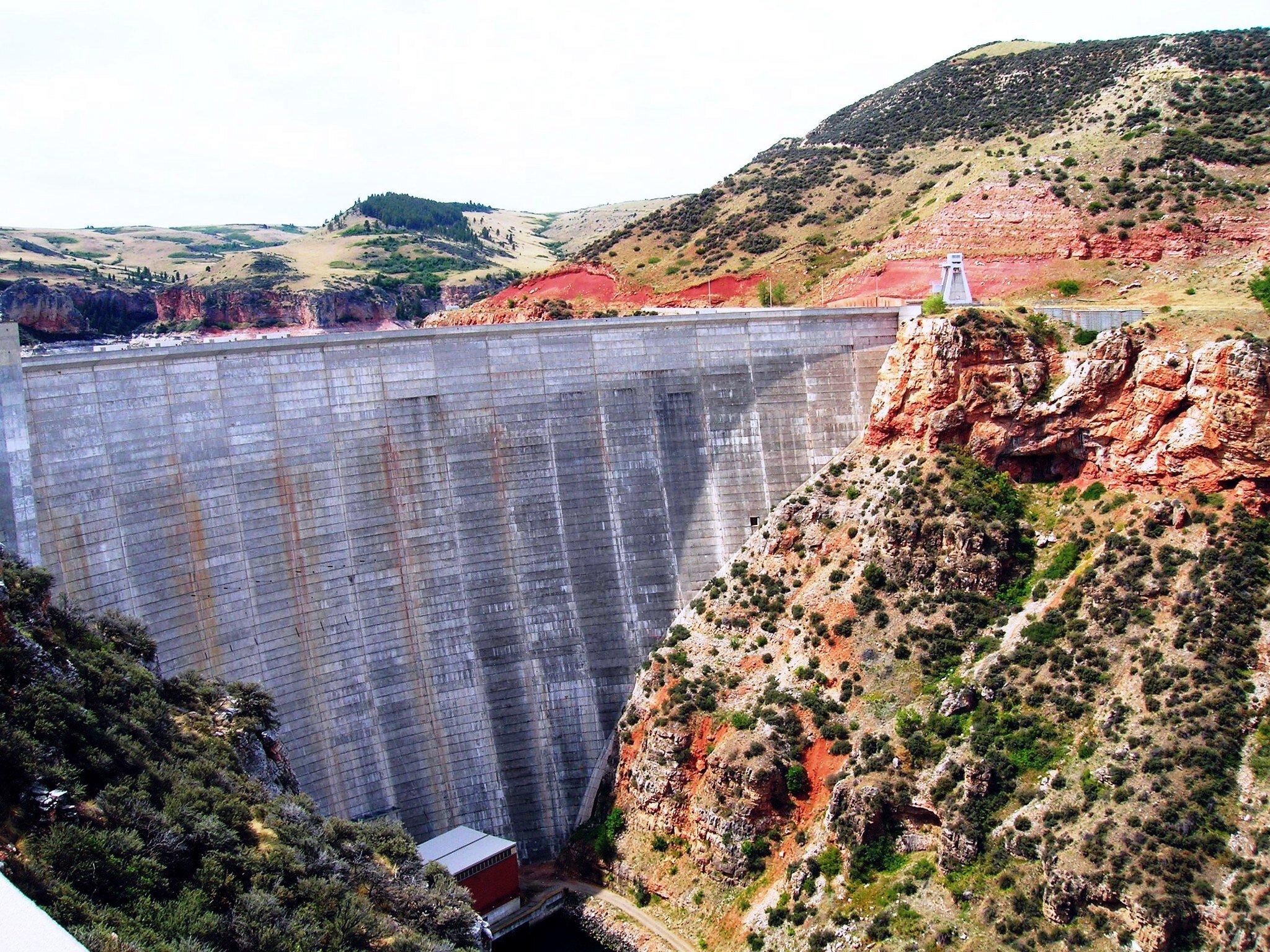Big Horn County, Montana: Leaving Coal Behind
This article is part ten in a new in-depth series we’re launching on the economic challenges facing resource-based communities, and strategies that can help build lasting prosperity. Read part nine here. Part eleven will be released tomorrow.
Yellowtail Dam. Image via Flickr.
Natural resources have been a mixed bag for Big Horn County, Montana. It’s classic Big Sky country, roughly equal in size to Connecticut. An abundance of arable soil, timber, water, and especially coal grace the county.
But prosperity gained through commodities never seemed to last, even when given a boost. The Yellowtail Dam, completed in 1967 across the Bighorn River, created impressive numbers: $100 million to build and 525 feet high, 250 megawatts of electricity, and thousands of acre feet of additional irrigation water. When promoting the project, Montana Senator James Murray wrote President Dwight Eisenhower, stating, “Yellowtail Dam is the key to a great deal of potential, permanent economic expansion in southeastern Montana.”
While recreational activities—fishing and boating—boomed as a result of the dam, the irrigation water and electric power sales created limited regional amplitude.
Instead, the county shuffled along, doing its best to deal with boom and bust. Sugar beets took a hit in 1971 when Holly Sugar closed its processing plant in Hardin, the county seat, putting 125 people out of work and sending Hardin, as a writer for the Billings Gazette put it, “into a tailspin from which it has never fully recovered.”
Then came the decline of coal. Big Horn County had three mines. Decker Coal ended production and now concentrates on reclamation. Absaloka Mining extracts coal from reserves owned by the Crow (Apsáalooke) tribe. It’s managed by Westmoreland Mining LLC, a company that emerged after Westmoreland Coal filed for in 2018 for bankruptcy, $1.4 billion in debt. It has approximately five remaining years of viable reserves, according the Bureau of Land Management’s Robert Smith. Still, it generates $15 million annual for Crow tribe, their largest source of revenue.
Montana’s largest coal mine, Spring Creek, located in the southeast corner of the county, also went through bankruptcy. A federal judge recently blocked a 117-million-ton expansion.
Bigger issue: the timeline for coal obsolescence keeps contracting. Experts once thought coal would be around until 2050. The investment firm Morgan Stanley released a report in February predicting coal will disappear from the US power grid by 2033.
This is grim news for a struggling county. In 2021, Big Horn County had its fourth year in a row of population decrease. It has a poverty rate of 26%.
Coal’s disappearance effects vital institutions. Big Horn Memorial Hospital in Hardin has received millions in coal grant money, said hospital CEO Kristi Gatrell. “That’s going away,” she said. The hospital received a reprieve with federal emergency funding for COVID, but the hospital foundation had to borrow money to pay for a new $11 million emergency room.
Despite generous donations from the hospital employees ($350,000), the hospital struggles to keep their debt ratio in check. “We’ve had to hire a consulting company to help us figure out how to address this issue,” Gatrell says.
Image (with edits) via Flickr.
Turning the narrative around: education, community vitality, and the river.
In Big Horn County, tribes matter. The Crow Indian Reservation covers nearly two-thirds of Big Horn County’s land mass. Another 6.5% belongs to the Northern Cheyenne tribe. Any county shift in direction must include tribal input.
These reservations are beautiful but troubled with unemployment and drug epidemics. Tribal members were upfront and forthcoming about their problems. When it came to solutions, two topics kept resurfacing: education and community resilience.
Sidney Fitzpatrick, a Crow tribal elder and Big Horn County Commissioner, said, with a sweep of his hand, “Coal came in 1976. We’ve been relying on it for 50 years. It brought money, [but] it also brought problems: increased alcohol, drug abuse, and opioids, but mostly meth.”
“Those are human behaviors,” he said sympathetically, “but when they occur, you lose your culture of love, honor, and respect for work.”
Fitzpatrick believes dignity lies at the core of any functioning society. And the Crow Reservation, he declares, is not functioning the way it should.
The tribe, he said, needs to start thinking for itself, relying neither on government money nor the opinion those who want to keep the status quo. “Look how long we were stuck on coal.”
John Doyle, a former Big Horn County Commission and Crow Tribal elder, describes 2020, “as a year of lessons. We’re resistant to change.” Doyle was referring to society’s response to COVID in particular, but the attitude towards change in general. “Personally, my observation is that we’ve seen a decline in coal for a number of years. It’s just that [the] state government didn’t anticipate the challenges that would arise.”
Doyle says it’s time to emphasize a more fundamental growth model: education and community development. To that end, he and others on the reservation are putting their energy into Little Big Horn College, a public tribal land-grant community college located in Crow Agency.
Students from Little Big Horn College studying botany in the field. Image via Flickr.
For Charlene Johnson, it’s about capacity and education. “We want to give all the assistance we can to Little Big Horn College. Specifically, we want to work on workforce development. We’ve got a housing crunch and crowding and no access to services, like plumbing and electrical. So, we’re trying to create those businesses. Also, building capacity to address our water and infrastructure.”
Johnson is executive director of Plenty Doors Community Development Corporation, a 501-C3 also located in Crow Agency. Doyle is a vice president.
Johnson expresses an almost an existential examination of the tribe’s struggles. “We’re interested in exploring just how deep is our problem, then building the capacity to address those problems. We see the college as a place to build that capacity. If we want to achieve any sort of independence from outside forces, it’s going to have to start at the college.”
Plenty Doors, says president Curtis Yarlott, concentrates on two goals. “One, attend to the daily needs and wants of reservation residents. Once you’ve addressed that, you create bandwidth for more possibilities.”
Yarlott should know. In his self-described day job, Yarlott is executive director of St. Labre Indian School, which has three campuses located on the Northern Cheyenne and Crow reservations. High school students from the Ashland campus have a 93% graduation rate and an 81% college attendance rate.
Sending young tribal members on to higher education remains key for tribal transition. “This could be college or trade school,” says Yarlott. “We need to expose our youth to other ideas and possibilities. Give them a license to explore. This exposure allows them to ask what is a good path forward.”
“We need to get those kids back to the reservation after they graduate,” says Fitzgerald.
Then there’s the river. The economics surrounding the Bighorn River renown tailwater fishery are dizzying. The most recent figures (2017) for Bighorn River angler contributions annual totals $88,365,221.
“The tribe needs to think differently about water. Very differently. Electricity generated by the dam. Fishing. Everything,” says Fitzpatrick.
The Little Bighorn Battlefield National Monument. Image via Flickr.
Yarlott says the Crow need to do a better job of engaging the thousands of annual visitors to the Little Bighorn Battlefield National Monument located in Crow Agency. In 2019, it had 241,000 visitors, according to National Park Service figures. It generated an estimated $14.4 million in visitor spending, supported 220 jobs, and resulted in $18.9 million in local economic impact.
Fitzpatrick says the tribes need to pay attention to what they have in their front yard.
“Listen,” he says pointing out the window towards Interstate 90. “You know what the sound is? That’s the music of commerce. We also have a railroad running right through our reservation.”
Curiously, no interviewee mentioned Big Horn County’s proximity to Montana’s largest city, Billings. It’s 50 miles away on an interstate. That inattention may not last. The average price of home in Billings jumped 24% in 2020, according to Coldwell Bankers. Total sales almost reached $1 billion. Big Horn County may soon have another form of revenue: real estate.
Samuel Western has served in the Swedish Merchant Marine, worked as a commercial fisherman, a longshoreman, logger, and a hunting guide. He has published in the Economist, LIFE, and Sports Illustrated. A two-time recipient of the Wyoming Literary Fellowship for fiction, he is also a finalist for the High Plains Books Award for poetry. He lives in Sheridan, Wyoming.
















The generational ranch model has been wobbling since WWII, but here's how one small community in Montana is keeping grazing land as working lands, as well as bolstering opportunities for young producers.